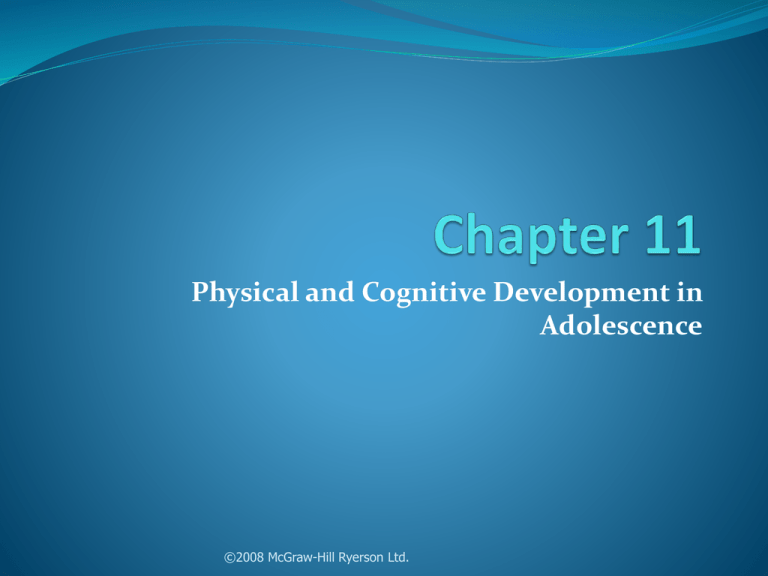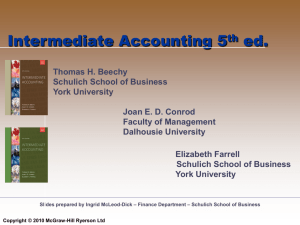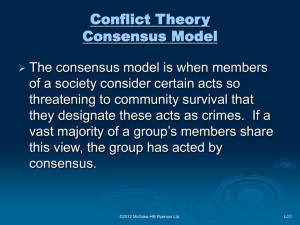
Physical and Cognitive Development in
Adolescence
©2008 McGraw-Hill Ryerson Ltd.
Physical and Cognitive
Development in Adolescence
The Nature
Of Adolescence
Adolescent
Cognition
Adolescent Health
Problems and
Wellness
Puberty
Adolescent
Sexuality
©2008 McGraw-Hill Ryerson Ltd.
Nature of Adolescence
Genetic, biological,
Thoughts are more
environmental, & social
factors interact in teen
development.
Continuity/discontinuity
both play a role.
Dating begins.
Relationships with
parents take a different
form.
abstract & idealistic.
Biological changes
trigger a heightened
interest in body image.
Generally, adolescents
have positive selfconcepts & good
relationships with
others.
©2008 McGraw-Hill Ryerson Ltd.
Puberty
Individual
Variation
Early and
Late Maturation
Hormonal
Changes
Body
Image
Height, Weight,
and Sexual Maturation
©2008 McGraw-Hill Ryerson Ltd.
Puberty
Definition of Puberty
Puberty is a period of rapid physical
maturation involving hormonal & bodily
changes that occur primarily during early
adolescence.
©2008 McGraw-Hill Ryerson Ltd.
Puberty
Individual Variation in Puberty
Puberty determinants
include:
Nutrition
Health
Heredity
Body mass
©2008 McGraw-Hill Ryerson Ltd.
Puberty
Individual Variation in Puberty
Boys – pubertal
sequence begins
between ages 10-13.5
yrs.
Girls – normal range is
between 8- 16 yrs.
(onset of menarche,
or first menstrual
period).
©2008 McGraw-Hill Ryerson Ltd.
Puberty
What are Hormones?
Powerful chemical
substances secreted by the
endocrine glands & carried
through the body by the
bloodstream
©2008 McGraw-Hill Ryerson Ltd.
Puberty
Endocrine System
Hypothalamus – a structure in the higher
portion of the brain that monitors eating,
drinking, & sex
Pituitary gland – an endocrine gland that
controls growth & regulates other glands
Gonads – the sex glands (testes in males, ovaries
in females)
Gonadotropins – hormones that stimulate the
testes or ovaries
©2008 McGraw-Hill Ryerson Ltd.
Puberty
Hormonal Changes
Puberty involves the interaction of the endocrine
system’s hypothalamus, pituitary gland, & gonads.
The pituitary gland also interacts with the thyroid
gland to produce growth & skeletal maturation.
Concentrations of certain hormones (testosterone,
estradiol) increase dramatically during adolescence.
Hormones contribute to both physical &
psychological development.
©2008 McGraw-Hill Ryerson Ltd.
Puberty
Height and Weight
Growth spurt – occurs about 2 years earlier for girls.
Mean age of growth spurts – age 9 for girls; age 11 for
boys.
Peak rate of pubertal change – age 11.5 for girls; age
13.5 for boys.
Height increases – about 9 cm per year for girls;
about 10.6 cm for boys.
Weight increases follow a similar timetable as
height.
©2008 McGraw-Hill Ryerson Ltd.
Puberty
Sexual Maturation in Boys
Increase in penis &
Appearance of kinky
testicle size
Straight pubic hair
appears
Minor voice change
Growth of facial hair
First ejaculation
pubic hair
Onset of maximum
growth
Growth of hair in
armpits
More detectable voice
change
©2008 McGraw-Hill Ryerson Ltd.
Puberty
Sexual Maturation in Girls
Breasts enlarge
First menstruation comes
rather late in puberty
Pubic hair appears
Menstrual cycles are often
Hair appears in the
highly irregular
armpits
Some girls aren’t fertile
Growth in height
until 2 years later.
Hips become wider than Breasts are fully rounded
shoulders
by the end of puberty
©2008 McGraw-Hill Ryerson Ltd.
Puberty
Body Image
Preoccupation with body image occurs in adolescence.
Wright (1989) found adolescents are more dissatisfied
with their bodies during puberty than in late
adolescence.
Brooks-Gunn & Paikoff (1993) found girls are less
happy with their bodies & have more negative body
images than boys throughout puberty.
Gross (1994) determined that during puberty, girls
often become dissatisfied with their bodies due to the
increase in body fat, while boys become more satisfied
due to the increase in muscle mass.
©2008 McGraw-Hill Ryerson Ltd.
Puberty
Early and Late Maturation in Boys
Simmons & Blyth’s (1987) research confirms
that during adolescence, it is advantageous to be
an early-maturing rather than late-maturing boy.
Early maturing boys appear to perceive
themselves more positively & have more
successful peer relations than their latematuring counterparts.
©2008 McGraw-Hill Ryerson Ltd.
Puberty
Early and Late Maturation in Girls
Simmons & Blyth (1987) recent findings suggest
that early-maturing girls experience more
problems in school.
They also experience more independence &
popularity with boys.
In 6th grade, early-maturing girls show greater
satisfaction with their figures, but by 10th grade,
late-maturing girls are more satisfied.
©2008 McGraw-Hill Ryerson Ltd.
Adolescent
Sexuality
Developing a
Sexual Identity
The Progression
of Adolescent
Sexual Behaviours
©2008 McGraw-Hill Ryerson Ltd.
Risk Factors
and Sexual
Problems
Adolescent Sexuality
Adolescent Sexuality
Adolescence is a time of sexual exploration &
experimentation.
Adolescence is a bridge between the asexual child
& the sexual adult.
Sexual development & interest are normal aspects
of adolescent development.
The majority of adolescents have healthy sexual
attitudes & engage in sexual practices that will not
compromise their development.
©2008 McGraw-Hill Ryerson Ltd.
Adolescent Sexuality
Adolescent Sexuality
The World Health
Organization defines sexual
health as:
the integration of the physical,
emotional, intellectual & social
aspects of sexual being in ways
that are positively enriching &
that enhance personality,
communication & love.
©2008 McGraw-Hill Ryerson Ltd.
Adolescent Sexuality
Developing a Sexual Identity
Sexual identity
involves:
an indication
of sexual
orientation
activities
interests
styles of
behaviour
©2008 McGraw-Hill Ryerson Ltd.
Adolescent Sexuality
The Progression of Adolescent Sexual
Behaviour
8 in 10 girls are virgins at age 15.
7 in 10 boys are virgins at age 15.
Adolescents engage in a consistent progression of
sexual behaviours:
Necking
Petting
Intercourse/Oral sex
©2008 McGraw-Hill Ryerson Ltd.
Adolescent Sexuality
Risk Factors and Sexual Problems
Adolescents who engage in sex before age 16 are
the least effective users of contraception.
They are also at risk for unintended pregnancy and
sexually transmitted diseases.
Early sexuality is also linked with excessive
drinking and drug use.
©2008 McGraw-Hill Ryerson Ltd.
Adolescent Sexuality
Contraceptive Use
Two kinds of risks that
youth encounter:
unintended/unwante
d pregnancy
sexually transmitted
diseases
Both of these risks can
be reduced significantly
if contraception is used.
Adolescents are
increasing contraceptive
use.
Younger adolescents are
less likely to use them.
©2008 McGraw-Hill Ryerson Ltd.
Adolescent Sexuality
Sexually Transmitted Infections and
Diseases
Sexually transmitted diseases (STDs) are
contracted primarily through sexual contact,
which is not limited to sexual intercourse. Oralgenital and anal-genital contact also can be
involved in STDs.
Chlamydia and gonorrhea are more common
among adolescents than young adults.
©2008 McGraw-Hill Ryerson Ltd.
Adolescent Sexuality
Adolescent Pregnancy
Each year, more than 40,000
teenage pregnancies occur
in Canada.
The teen pregnancy rate did
decline slightly in the 1990s.
Most adolescent pregnancies
are unplanned.
Regional differences exist
across Canada.
©2008 McGraw-Hill Ryerson Ltd.
Adolescent Sexuality
Consequences of Adolescent Pregnancy
Adolescent pregnancy creates health risks for
both the offspring & the mother.
Adolescent mothers often drop out of school.
Infants born to teen mothers are more likely to
have:
low birthweights
neurological problems
childhood illness
©2008 McGraw-Hill Ryerson Ltd.
Adolescent Sexuality
Reducing Adolescent Pregnancy
Sex education and family planning
Access to contraceptive methods
The life-options approach
Broad community involvement and support
Abstinence, especially for young adolescents
©2008 McGraw-Hill Ryerson Ltd.
Adolescent Health
Problems and Wellness
Teen
Depression
Leading Causes of Death
In Adolescence
Substance Use
and Addiction
Eating
Disorders
Risk, Vulnerability, and the Roles of
Parents and Peers
©2008 McGraw-Hill Ryerson Ltd.
Adolescent Health Problems and Wellness
Teen Depression
Depression is defined as experiencing over a
prolonged period of time a range of symptoms
including fatigue, irritability, inability to make
decisions, sleeping problems, lack of interest in daily
activities, and suicidal thoughts.
Boys were half as likely to suffer from depression.
©2008 McGraw-Hill Ryerson Ltd.
Adolescent Health Problems and Wellness
Higher Rates of Depression in Females
Females tend to internalize emotions.
Females tend to ruminate in their depressed
mood and amplify it.
Females’ self-image, especially their body images,
are more negative than those of males.
Females face more discrimination than do males.
©2008 McGraw-Hill Ryerson Ltd.
Adolescent Health Problems and Wellness
Substance Use and Addiction
Dopamine in the Brain
Alcohol
Cigarette Smoking
Gambling
©2008 McGraw-Hill Ryerson Ltd.
Adolescent Health Problems and Wellness
Dopamine in the Brain
Dopamine is one of the key brain
chemicals that carry & influence messages
between nerve cells.
It is heavily involved with pleasure –
reward circuit of the brain.
All addictive drugs artificially increase
the amount of dopamine in the reward
centres of the inner brain by either jumpstarting its release or prolonging its stay.
©2008 McGraw-Hill Ryerson Ltd.
Adolescent Health Problems and Wellness
Alcohol
Alcohol is the drug most widely used by
adolescents in our society.
Since 1980, alcohol related deaths among teenage
drivers has dropped by 61% in Canada.
©2008 McGraw-Hill Ryerson Ltd.
Adolescent Health Problems and Wellness
Cigarette Smoking
Begins primarily during childhood & adolescence.
A study found that once young adolescents begin
smoking, the addictive properties of nicotine
make it extremely difficult for them to stop.
The early age of onset of smoking is more
important in predicting genetic damage than how
much individuals smoke.
©2008 McGraw-Hill Ryerson Ltd.
Adolescent Health Problems and Wellness
Gambling
Gambling is a hidden addiction because
it has no visible signals.
About 80% of Canadians gamble.
The number of pathological gamblers in
Canada may be as high as 1.2 million.
Gambling has become increasingly popular
with high school students.
©2008 McGraw-Hill Ryerson Ltd.
Adolescent Health Problems and Wellness
Risk, Vulnerability, and the Role of Parents
and Peers
Drug use in childhood or early adolescence has
more detrimental long-term effects on the
development of responsible, competent behaviour
than when drug use occurs in late adolescence.
Positive relationships with parents & others are
important in reducing adolescents’ drug use.
Adolescents are most likely to take drugs when
both of their parents take drugs & when their peers
take drugs.
©2008 McGraw-Hill Ryerson Ltd.
Adolescent Health Problems and Wellness
Eating Disorders
Anorexia Nervosa
Bulimia Nervosa
©2008 McGraw-Hill Ryerson Ltd.
Adolescent Health Problems and Wellness
Anorexia Nervosa
An eating disorder that
Distorted perception of
involves the relentless
pursuit of thinness
through starvation; can
lead to death.
Anorexics often weigh less
than 85% of what is
considered normal.
Intense fear of gaining
weight does not dissipate
with weight loss.
body shape drives constant
weighing & starving.
Most are White adolescent
or young adult females
from well-educated,
middle & upper income
families.
High standards & stress at
not reaching them are
factors.
©2008 McGraw-Hill Ryerson Ltd.
Adolescent Health Problems and Wellness
Bulimia Nervosa
An eating disorder in which the individual consistently
follows a binge-and-purge eating pattern.
Purging is accomplished through self-inducing
vomiting or use of a laxative.
Most bulimics are females in the teens to early twenties.
Most bulimics are preoccupied with food, have a strong
fear of becoming overweight, & are depressed or anxious.
Unlike anorexia, bingeing & purging occurs within a
normal weight range & is difficult to detect.
©2008 McGraw-Hill Ryerson Ltd.
Adolescent Health Problems and Wellness
Leading Causes of Death in
Adolescence
Accidents – most involve automobiles, and are the
result of risky driving habits and driving under the
influence of alcohol or drugs.
Suicide – accounts for 6% of the deaths in the 10–
14 age group, and 12% of deaths in the 15 – 19 age
group.
Alcohol and Illicit Drug Use – being under the
influence of alcohol or drugs may result in riskier
behaviour, which in turn results in more accident
fatalities.
©2008 McGraw-Hill Ryerson Ltd.
Adolescent
Cognition
Piaget’s
Theory
Adolescent
Egocentrism
©2008 McGraw-Hill Ryerson Ltd.
Information
Processing
Education
Adolescent Cognition
Piaget’s Theory
Adolescent thought is at the formal operational
stage.
Thought is more abstract, characterized by:
verbal problem-solving ability
increased tendency to think about thought itself
idealism and possibilities
more logical
hypothetical-deductive reasoning
©2008 McGraw-Hill Ryerson Ltd.
Adolescent Cognition
Hypothetical-Deductive Reasoning
Piaget’s formal operational - adolescents have the
cognitive ability to develop hypotheses, or best
guesses, about ways to solve problems, such as an
algebraic equation. They then systematically deduce,
or conclude, which is the best path to follow in solving
the equation.
©2008 McGraw-Hill Ryerson Ltd.
Adolescent Cognition
Adolescent Egocentrism
Egocentrism is the heightened self-consciousness
of adolescents, reflected in their belief that
others are as interested in them as they
themselves are, & in their sense of personal
uniqueness.
Dissected into two types of social thinking:
imaginary audience
personal fable
©2008 McGraw-Hill Ryerson Ltd.
Adolescent Cognition
Imaginary Audience
Imaginary Audience refers to the heightened self-
consciousness of adolescents, reflected in their belief
that others are as interested in them as they
themselves are.
Involves attention-getting behaviour—the attempt to
be noticed, visible, & the sense of being “on stage.”
©2008 McGraw-Hill Ryerson Ltd.
Adolescent Cognition
Personal Fable
Personal fable is the part of adolescent egocentrism
involving an adolescent’s sense of uniqueness &
invulnerability.
Adolescents feel that no one can understand how they
really feel.
Personal fables frequently show up in adolescent
diaries.
©2008 McGraw-Hill Ryerson Ltd.
Adolescent Cognition
Information Processing
Decision Making
Critical Thinking
©2008 McGraw-Hill Ryerson Ltd.
Adolescent Cognition
Decision Making
Increased decision making opportunities occur
in adolescence.
Compared with children, young adolescents are
more likely to generate options, examine a
situation from a variety of perspectives, anticipate
the consequences of decisions, & consider the
credibility of sources.
Parents should involve adolescents in
appropriate decision-making activities.
©2008 McGraw-Hill Ryerson Ltd.
Adolescent Cognition
Critical Thinking
A solid basis of fundamental skills is necessary for the
development of critical thinking skills.
Recent studies have shown critical thinking increases with
age, but still only occurs less than half the time with
eleventh grade students.
Cognitive changes that allow improved critical thinking
are:
increased speed and capacity of information processing
more breadth of content knowledge in a variety of areas
increased ability to construct new knowledge combinations
a greater range and more spontaneous use of strategies
©2008 McGraw-Hill Ryerson Ltd.
Adolescent Cognition
©2008 McGraw-Hill Ryerson Ltd.
Adolescent Cognition
Education
Effective Schools
High School Dropouts
©2008 McGraw-Hill Ryerson Ltd.
Adolescent Cognition
Effective Schools
Effective schools offer more than the “3 Rs”; they
are accountable and responsible to public
scrutiny.
Trademarks of effective schools:
Effective leadership
Clear academic goals
A safe and orderly climate
Expectation of minimum mastery of skills
Testing for program evaluation and redirection
Parental involvement
Collegiality
©2008 McGraw-Hill Ryerson Ltd.
Adolescent Cognition
Hidden Curriculum
The “hidden curriculum” is conveyed by the moral
atmosphere that is a part of every school.
The moral atmosphere is created by school and classroom
rules, the moral orientation of teachers and school
administrators, and text materials.
Teachers serve as models of ethical and unethical
behaviour.
Through rules and regulations, school administrations
infuse a school with a value system.
©2008 McGraw-Hill Ryerson Ltd.
Adolescent Cognition
High School Dropouts
In the last 50 years the school completion rate in
Canada has increased from 50% to 80%.
Almost 50% of those who leave school return by
age 20 to complete their high school education.
Aboriginal youth have a disproportionately high
rate of leaving school – approximately 70%.
Nova Scotia reports the lowest provincial dropout
rate of 13%.
©2008 McGraw-Hill Ryerson Ltd.
Adolescent Cognition
Who Leaves School?
Characteristics of people who leave school:
Are disabled
Have dependants
Have fathers that didn’t complete high school
Have changed schools a number to times
Live with friends or alone rather than with families
Work
Are male
Live common law or have been separated or divorced
Have parents or friends who do not consider school
important
©2008 McGraw-Hill Ryerson Ltd.




